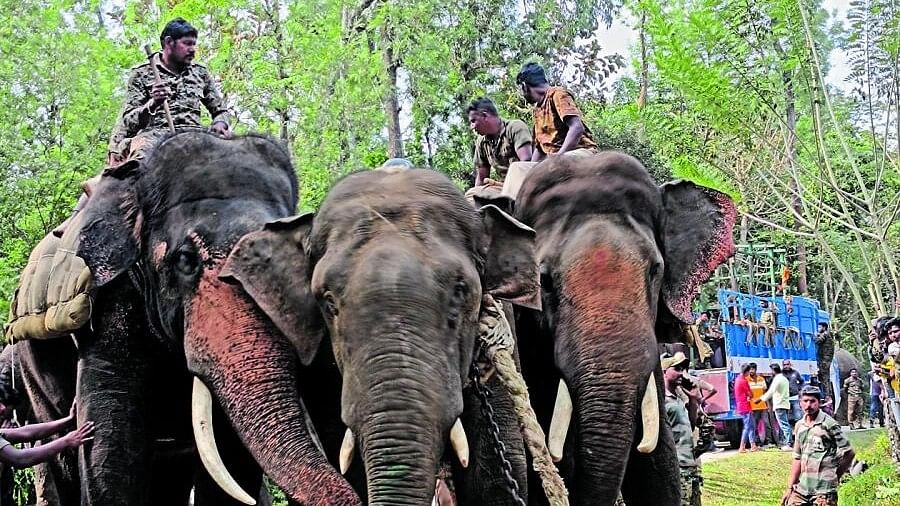
Elephants representative image.
Credit: DH Photo
Currently in Karnataka, Operation Jumbo, an initiative aimed at capturing what the Karnataka forest department and the media term “rogue” elephants, is underway. The chief conservator of forests has informed the media that in a month the department aims at capturing elephants “entering habitats” in Alur, Sakleshpur, Belur, and Arkalgud to move them to camps. Eight kumkis (wild elephants tamed to capture other wild elephants) are being used for this operation.
Elephant-human interactions in Hassan have been observed since the late 1980s. The capture of elephants for translocation or permanent captivity has been a mitigation measure in the area since the late 1990s, with increasing intensity over the years. In 2006, a committee led by scientists recommended the removal of 25 elephants. In 2012, the Karnataka Elephant Task Force proposed a zone-based approach, including a Removal Zone for regions with intense interactions, like the Alur-Arkalgud area. They recommended setting up barricades before removal to ensure other elephants wouldn’t enter.
Despite evidence showing the futility of capturing elephants for translocation or permanent captivity as a mitigation measure, it is still being pursued in Hassan. While capture may be useful in isolated and unviable areas of elephant interactions or in areas with extensive habitat degradation, neither applies to Hassan, where, since 2013, over 35 elephants have been captured or translocated.
What has transpired in Hassan since, or continues to, shouldn’t be surprising. The landscape remains connected to critical conservation habitats and elephant dispersal/origin areas. Elephants don’t understand borders or man-made zones. They are highly adaptable, and learned to cross barricades. Many translocated elephants returned, and new herds occupied the vacated landscape. Interactions have spread to newer areas. Today, Hassan has over 50 elephants, and interactions are equally intense.
Despite the increased number of deaths during capture operations, elephants are still being captured, sometimes with protocol violations such as using kumkis in musth, or capturing those in musth. It is expensive and labour-intensive. Studies have shown the effect of removing only males, the impact on young peers, and the male and female sex ratios in the wild. Let’s not get to the state of wild elephants in permanent captivity and the use of kraals. While this operation is underway, some foresters have raised concerns about a lack of space in the state rescue centres, which currently host over 100 captured elephants, many of whom are used as kumkis.
A few foresters I interacted with in Hassan and Kodagu reported immense pressure from locals, “with the majority asking for removal as the only action.” Is removal the only option because of the extensive endorsement by the forest department, a few scientists, politicians, and the media? Would we have witnessed a departure from capture if other long-term measures had been planned and implemented jointly with the farmers and the local community? Though human-elephant interactions have increased nationwide, Karnataka remains the only state resorting aggressively to this solution.
Is rogue elephant even an actual term? Who are they, and why are they termed rogues? Is it their doing? Over the past few years, human-elephant interactions have increased exponentially. There are many reasons, such as habitat fragmentation. Large tracts of the animals’ migratory routes today are agricultural farms/roads, etc. Habitat degradation: grasslands, popularly termed wastelands in India, are being destroyed; invasive species are overtaking forests; changing weather patterns (lack of water); and a few ill-planned compensatory afforestation projects are a few reasons, among many others. Studies have repeatedly spoken of human-dominated landscapes as prime elephant habitats and not merely marginal areas that elephants use without other options. It’s no surprise that elephants move through connected forests, crossing agroforests, plantations, crop fields, etc., for food, mates and friends. Here, they come in contact with humans, sometimes leading to crop loss and damage to property. Other times, not deliberately or intentionally, but “accidentally”, to human deaths. These elephants ‘entering habitats’ are termed rogues.
So, here we are:
2012: Plans afoot to capture elephants in Alur-Arkalgud.
2024: Plans afoot to capture elephants in Alur-Arkalgud
Nothing has changed except for cases of interactions.
(The writer is an independent environment reporter)